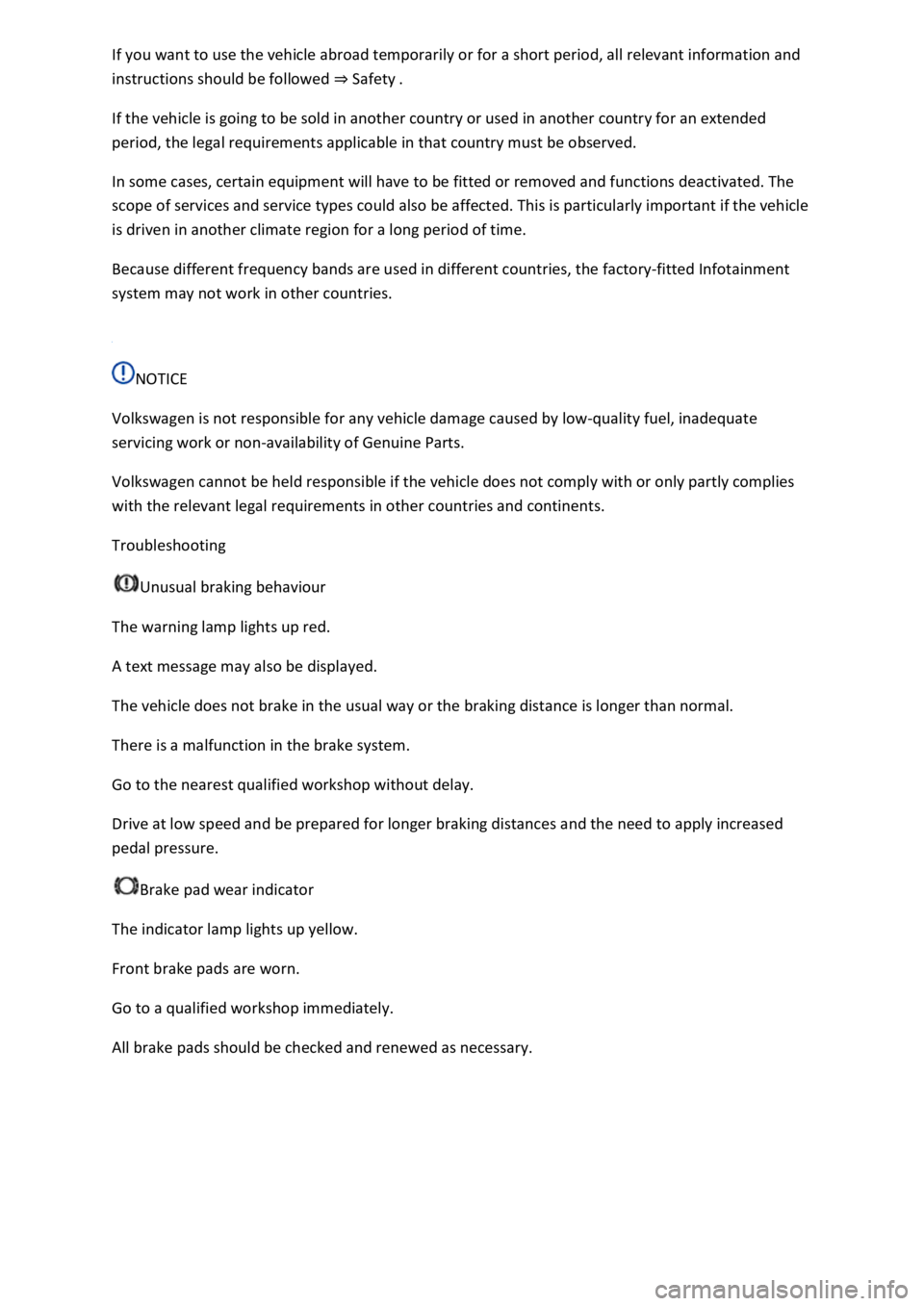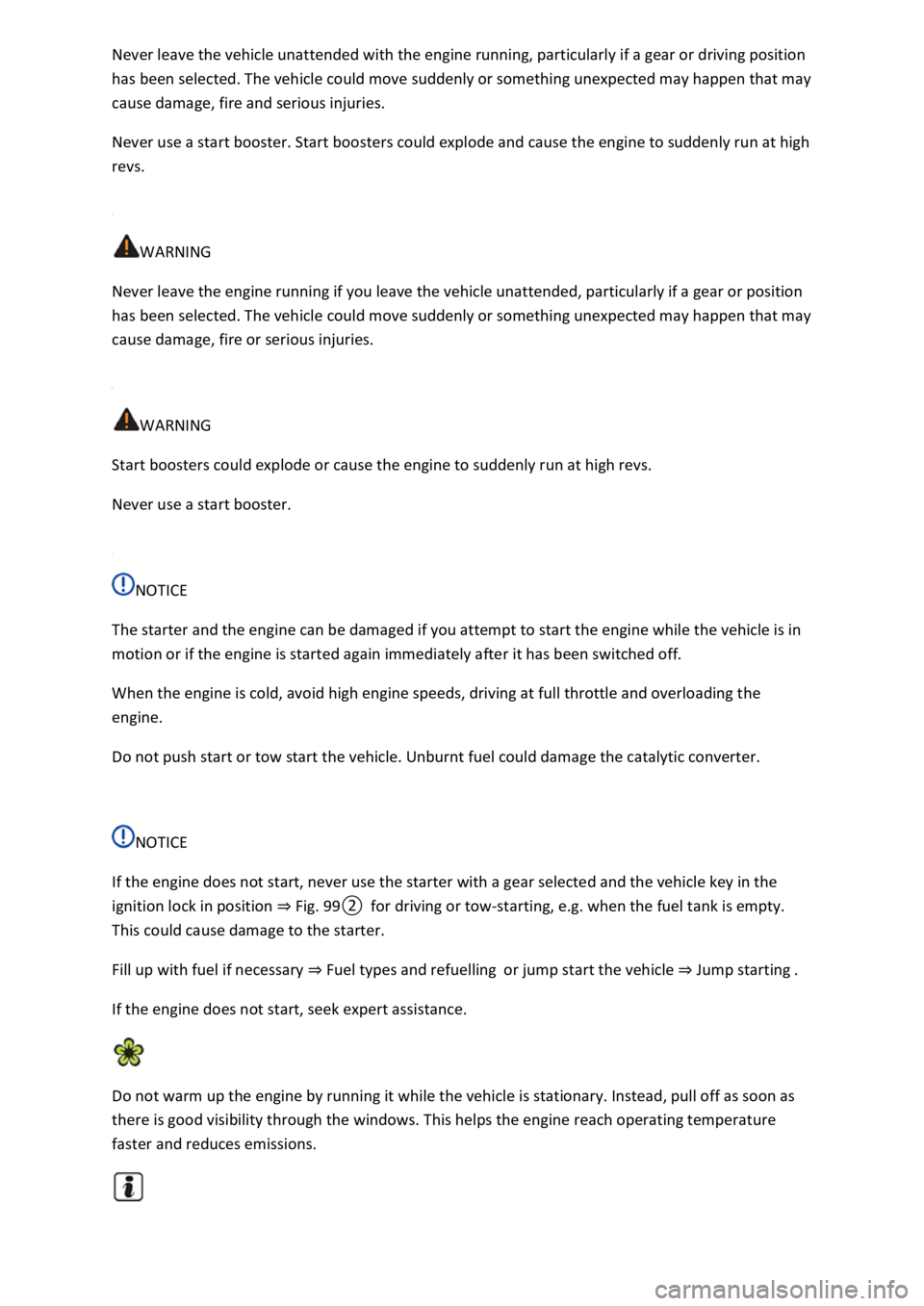Page 180 of 502

instructions should be followed Safety
If the vehicle is going to be sold in another country or used in another country for an extended
period, the legal requirements applicable in that country must be observed.
In some cases, certain equipment will have to be fitted or removed and functions deactivated. The
scope of services and service types could also be affected. This is particularly important if the vehicle
is driven in another climate region for a long period of time.
Because different frequency bands are used in different countries, the factory-fitted Infotainment
system may not work in other countries.
NOTICE
Volkswagen is not responsible for any vehicle damage caused by low-quality fuel, inadequate
servicing work or non-availability of Genuine Parts.
Volkswagen cannot be held responsible if the vehicle does not comply with or only partly complies
with the relevant legal requirements in other countries and continents.
Troubleshooting
Unusual braking behaviour
The warning lamp lights up red.
A text message may also be displayed.
The vehicle does not brake in the usual way or the braking distance is longer than normal.
There is a malfunction in the brake system.
Go to the nearest qualified workshop without delay.
Drive at low speed and be prepared for longer braking distances and the need to apply increased
pedal pressure.
Brake pad wear indicator
The indicator lamp lights up yellow.
Front brake pads are worn.
Go to a qualified workshop immediately.
All brake pads should be checked and renewed as necessary.
Page 185 of 502

has been selected. The vehicle could move suddenly or something unexpected may happen that may
cause damage, fire and serious injuries.
Never use a start booster. Start boosters could explode and cause the engine to suddenly run at high
revs.
WARNING
Never leave the engine running if you leave the vehicle unattended, particularly if a gear or position
has been selected. The vehicle could move suddenly or something unexpected may happen that may
cause damage, fire or serious injuries.
WARNING
Start boosters could explode or cause the engine to suddenly run at high revs.
Never use a start booster.
NOTICE
The starter and the engine can be damaged if you attempt to start the engine while the vehicle is in
motion or if the engine is started again immediately after it has been switched off.
When the engine is cold, avoid high engine speeds, driving at full throttle and overloading the
engine.
Do not push start or tow start the vehicle. Unburnt fuel could damage the catalytic converter.
NOTICE
If the engine does not start, never use the starter with a gear selected and the vehicle key in the
ignition lock in position Fig.
0for driving or tow-starting, e.g. when the fuel tank is empty.
This could cause damage to the starter.
Fill up with fuel if necessary Fuel types and refuellingor jump start the vehicle Jump starting
If the engine does not start, seek expert assistance.
Do not warm up the engine by running it while the vehicle is stationary. Instead, pull off as soon as
there is good visibility through the windows. This helps the engine reach operating temperature
faster and reduces emissions.
Page 322 of 502
879 mm
at least 65 mm
350 420 mm
334 mm
554 mm
1,017 mm
1,051 mm
WARNING
Electrical cables that are not connected properly or are connected incorrectly can cause faults in the
entire vehicle electronics system and also cause accidents and serious injuries.
clusters or to other unsuitable power sources. Use only suitable connectors for connection of the
trailer.
WARNING
The trailer can become detached from the towing vehicle if the towing bracket is unsuitable or
incorrectly fitted. This can cause serious accidents and fatal injuries.
Use only towing brackets which have been approved by Volkswagen for your vehicle type.
Fuel and emission control
Safety notes on handling fuel
WARNING
Incorrect handling of fuel can cause explosions, fire, serious burns and other injuries.
Switching the auxiliary heater and ventilation on and
off
Page 323 of 502
WARNING
Filling the tank with the wrong fuel can damage the vehicle.
uels that have been approved for the vehicle.
-approved service additives in the
approved quantity.
CAUTION
Fuel may run out of a fuel canister. This could cause fire and injuries.
Fuels can pollute the environment. Collect any service fluids that escape or are spilled and dispose of
them correctly.
The tank flap cannot be opened manually. Seek expert assistance in an emergency.
Fuel types and refuelling
Introduction
This chapter contains information on the followingsubjects:
Fuel standards
Petrol
Diesel
The tank flap is located at the rear right-hand side of the vehicle.
Different engines require different fuels. There is a factory-fitted sticker in the tank flap that
indicates the required fuel type for the vehicle.
Page 392 of 502

Tyre
pressure
an extent that the tread peels off and the tyre bursts.
Tyre pressure
eck the tyre pressure regularly when the tyres are cold. If necessary, adjust the tyre pressure in
the cold tyre to the recommended tyre pressure for the tyres installed on your vehicle Tyre
pressure
amage.
If the tyre pressure is too low, this will increase fuel consumption and tyre wear.
When new tyres are driven at high speeds for the first time, they can expand slightly and trigger a
one-off pressure warning.
Old tyres should be replaced only by tyres that have been approved by Volkswagen for the vehicle
type.
Do not rely solely on the tyre monitoring system. Check your tyres regularly to ensure that they are
properly inflated and have no signs of damage, such as punctures, cuts, cracks, and blisters. Remove
any objects that become embedded in the tyre tread but have not penetrated into the body of the
tyre itself.
Tyre Pressure Loss Indicator
First read and observe the introductoryinformation and safety warnings
Functional description
The Tyre Pressure Loss Indicator uses data from the ABS sensors and other functions to compare the
speed of rotation and the rolling circumference of the individual wheels.
The rolling circumference can change: